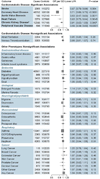Phenotypic Characterization of Genetically Lowered Human Lipoprotein(a) Levels
- PMID: 28007139
- PMCID: PMC5328146
- DOI: 10.1016/j.jacc.2016.10.033
Phenotypic Characterization of Genetically Lowered Human Lipoprotein(a) Levels
Abstract
Background: Genomic analyses have suggested that the LPA gene and its associated plasma biomarker, lipoprotein(a) (Lp[a]), represent a causal risk factor for coronary heart disease (CHD). As such, lowering Lp(a) levels has emerged as a therapeutic strategy. Beyond target identification, human genetics may contribute to the development of new therapies by defining the full spectrum of beneficial and adverse consequences and by developing a dose-response curve of target perturbation.
Objectives: The goal of this study was to establish the full phenotypic impact of LPA gene variation and to estimate a dose-response curve between genetically altered plasma Lp(a) and risk for CHD.
Methods: We leveraged genetic variants at the LPA gene from 3 data sources: individual-level data from 112,338 participants in the U.K. Biobank; summary association results from large-scale genome-wide association studies; and LPA gene sequencing results from case subjects with CHD and control subjects free of CHD.
Results: One SD genetically lowered Lp(a) level was associated with a 29% lower risk of CHD (odds ratio [OR]: 0.71; 95% confidence interval [CI]: 0.69 to 0.73), a 31% lower risk of peripheral vascular disease (OR: 0.69; 95% CI: 0.59 to 0.80), a 13% lower risk of stroke (OR: 0.87; 95% CI: 0.79 to 0.96), a 17% lower risk of heart failure (OR: 0.83; 95% CI: 0.73 to 0.94), and a 37% lower risk of aortic stenosis (OR: 0.63; 95% CI: 0.47 to 0.83). We observed no association with 31 other disorders, including type 2 diabetes and cancer. Variants that led to gain of LPA gene function increased the risk for CHD, whereas those that led to loss of gene function reduced the CHD risk.
Conclusions: Beyond CHD, genetically lowered Lp(a) levels are associated with a lower risk of peripheral vascular disease, stroke, heart failure, and aortic stenosis. As such, pharmacological lowering of plasma Lp(a) may influence a range of atherosclerosis-related diseases.
Keywords: coronary heart disease; genetics; phenome-wide association study; single nucleotide polymorphism.
Copyright © 2016 American College of Cardiology Foundation. Published by Elsevier Inc. All rights reserved.
Figures





Comment in
-
Using Human Genetics to Predict the Effects and Side Effects of Lipoprotein(a) Lowering Drugs.J Am Coll Cardiol. 2016 Dec 27;68(25):2773-2775. doi: 10.1016/j.jacc.2016.10.032. J Am Coll Cardiol. 2016. PMID: 28007140 No abstract available.
-
Dyslipidaemias: Cardiovascular effects of low Lp(a).Nat Rev Cardiol. 2017 Jan 17;14(2):67. doi: 10.1038/nrcardio.2016.220. Nat Rev Cardiol. 2017. PMID: 28094269 No abstract available.
References
-
- Utermann G. The mysteries of lipoprotein(a) Science. 1989;246:904–910. - PubMed
-
- Tsimikas S, Hall JL. Lipoprotein(a) as a potential causal genetic risk factor of cardiovascular disease: a rationale for increased efforts to understand its pathophysiology and develop targeted therapies. J Am Coll Cardiol. 2012;60:716–721. - PubMed
-
- Sandholzer C, Saha N, Kark JD, et al. Apo(a) isoforms predict risk for coronary heart disease. A study in six populations. Arterioscler Thromb. 1992;12:1214–1226. - PubMed
-
- Clarke R, Peden JF, Hopewell JC, et al. Genetic variants associated with Lp(a) lipoprotein level and coronary disease. N Engl J Med. 2009;361:2518–2528. - PubMed
Publication types
MeSH terms
Substances
Grants and funding
- KL2 TR001100/TR/NCATS NIH HHS/United States
- RC2 HL102923/HL/NHLBI NIH HHS/United States
- RG/13/13/30194/BHF_/British Heart Foundation/United Kingdom
- CS/14/2/30841/BHF_/British Heart Foundation/United Kingdom
- R01 HL127564/HL/NHLBI NIH HHS/United States
- MR/L003120/1/MRC_/Medical Research Council/United Kingdom
- RC2 HL102924/HL/NHLBI NIH HHS/United States
- R01 HL131961/HL/NHLBI NIH HHS/United States
- RC2 HL103010/HL/NHLBI NIH HHS/United States
- RC2 HL102925/HL/NHLBI NIH HHS/United States
- U54 HG003067/HG/NHGRI NIH HHS/United States
- RC2 HL102926/HL/NHLBI NIH HHS/United States
- MC_QA137853/MRC_/Medical Research Council/United Kingdom
- T32 HL007734/HL/NHLBI NIH HHS/United States
- K01 HL125751/HL/NHLBI NIH HHS/United States
- K08 HL114642/HL/NHLBI NIH HHS/United States
LinkOut - more resources
Full Text Sources
Other Literature Sources
Medical
Research Materials
Miscellaneous

